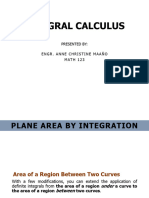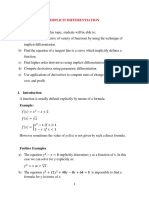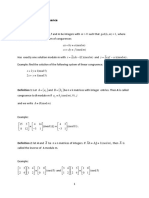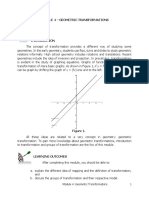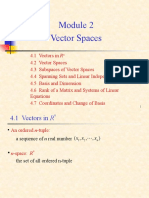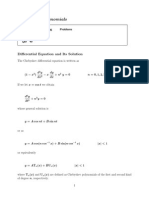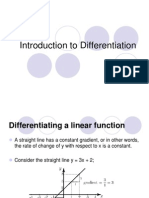Differentiation of Exponential Functions
Uploaded by
Prya Suthan SathiananthanDifferentiation of Exponential Functions
Uploaded by
Prya Suthan Sathiananthan5.
4 Differentiation of
Exponential Functions
By
Dr. Julia Arnold and Ms. Karen Overman
using Tans 5th edition Applied Calculus for the
managerial , life, and social sciences text
Lets consider the derivative of the exponential function.
Going back to our limit definition of the derivative:
( )
h
e e
lim e
dx
d
x h x
0 h
x
=
+
First rewrite the exponential
using exponent rules.
h
e e e
lim
x h x
0 h
Next, factor out e
x.
( )
h
1 e e
lim
h x
0 h
Since e
x
does not contain h, we
can move it outside the limit.
( ) | |
( ) ( )
h
x f h x f
lim
dx
d
0 h
+
=
x f
h
1 e
lim e
h
0 h
x
=
Substituting h=0 in the limit expression results in the
indeterminate form , thus we will need to determine it.
0
0
We can look at the graph of and observe what
happens as x gets close to 0. We can also create a table of
values close to either side of 0 and see what number we are
closing in on.
x
1 e
x f
x
= ) (
x -.1 -.01 -.001 .001 .01 .1
y .95 .995 .999 1.0005 1.005 1.05
Graph
At x = 0, f(0) appears to be 1.
Table
As x approaches 0, y approaches 1.
We can safely say that from the last slide that
1
h
1 e
lim
h
0 h
=
Thus
Rule 1: Derivative of the Exponential Function
( )
( )
x x
h
0 h
x x
e 1 e
h
1 e
lim e e
dx
d
= =
( )
x x
e e
dx
d
=
The derivative of the exponential function is the exponential function.
Example 1: Find the derivative of f(x) = x
2
e
x
.
Solution: Do you remember the product rule? You will need it
here.
2x e e x (x) f
e x f(x)
x x 2
x 2
+ =
'
=
Product Rule:
(1
st
)(derivative of 2
nd
) + (2
nd
)(derivative of 1
st
)
( ) 2 x xe (x) f
x
+ =
'
Factor out the common factor xe
x
.
Example 2: Find the derivative of f(t) = ( )
2
3
t
2 e +
Solution: We will need the chain rule for this one.
( )
( )
t
2
1
t
2
3
t
e 2 e
2
3
t f
2 e t f
+ =
'
+ =
) (
) (
Chain Rule:
(derivative of the outside)(derivative of the inside)
Why dont you try one: Find the derivative of . ( )
2
x
x
e
x f =
To find the solution you should use the quotient rule.
Choose from the expressions below which is the correct use of the
quotient rule.
( )
2x
e
x ' f
x
=
( )
( )
4
x x 2
x
2x e e x
x ' f
=
( )
( )
4
x 2 x
x
e x 2x e
x ' f
=
No thats not the right choice.
Remember the Quotient Rule:
(bottom)(derivative of top) (top)(derivative of bottom)
(bottom)
Try again. Return
Good work!
The quotient rule results in . ( )
( )
4
x x 2
x
2x e e x
x ' f
=
Now simplify the derivative by factoring the numerator and
canceling.
( )
( )
( )
( )
3
x
4
x
4
x x 2
x
2 x e
x ' f
x
2 x xe
x
2xe e x
x ' f
=
What if the exponent on e is a function of x and not just x?
Rule 2: If f(x) is a differentiable function then
( ) ) (
) ( ) (
x f e e
dx
d
x f x f
' =
In words: the derivative of e to the f(x) is an exact copy of
e to the f(x) times the derivative of f(x).
Example 3: Find the derivative of f(x) =
x 3
e
Solution: We will have to use Rule 2.
The exponent, 3x is a function of x whose derivative is 3.
3 e x f
e x f
x 3
x 3
=
'
=
) (
) (
An exact copy of
the exponential function
Times the derivative of
the exponent
Example 4: Find the derivative of
1 x 2
2
e x f
+
= ) (
Solution:
( ) 4x e (x) f
e f(x)
1 2x
1 2x
2
2
+
+
=
'
=
1 2x
2
4xe (x) f
+
=
'
Again, we used Rule 2. So the derivative
is the exponential function times the
derivative of the exponent.
Or rewritten:
Example 5: Differentiate the function
t t
t
e e
e
t f
+
= ) (
( ) ( )
( )
2
t t
t t t t t t
e e
e e e e e e
(t) f
+
+
=
'
Solution: Using the quotient rule
( )
( )
2
t t
0 2t 0 2t
t
e e
e e e e
(t) f
s. ' the into e Distribute
+
+ +
=
'
Keep in mind that the
derivative of e
-t
is e
-t
(-1)
or -e
-t
Recall that e
0
= 1.
( )
2
t t
e e
2
(t) f
+
=
'
Find the derivative of .
( )
5x
e x f =
Click on the button for the correct answer.
( )
5x 2
5e
x ' f
5x
=
( ) x e
x
5 x ' f
5
=
No, the other answer was correct.
Remember when you are doing the derivative of e raised to the
power f(x) the solution is e raised to the same power times the
derivative of the exponent.
What is the derivative of ?
Try again. Return
5x
Good work!!
Here is the derivative in detail.
( ) ( )
( ) ( ) ( )
( )
( )
5x 2
5e
x ' f
5x 2
5
e x ' f
5 5x
2
1
e x ' f
5x
d
e x ' f
5x
5x
2
1 -
5x
5x
=
=
=
=
dx
Example 6: A quantity growing according to the law
where Q
0
and k are positive constants and t
belongs to the interval experiences exponential growth.
Show that the rate of growth Q(t) is directly proportional to
the amount of the quantity present.
kt
0
e Q t Q = ) (
| ) , 0
Solution:
) ( ) (
) (
t kQ k e Q t Q
e Q t Q
kt
0
kt
0
= =
'
=
Remember: To say Q(t) is directly proportional to Q(t)
means that for some constant k, Q(t) = kQ(t) which was easy
to show.
Example 7: Find the inflection points of
2
x
e x f
= ) (
Solution: We must use the 2
nd
derivative to find inflection points.
( ) ( ) | | ( )
( )
2
2
2
1
x
2
1
x
1 x 2
0 e 2
1 x 2 e 2 0
e 2 e x 4 x f
2 e x 2 e x 2 x f
xe 2 x f
e x f
2
2
x
2 x
x x 2
x x
x
x
2
2
2 2
2 2
2
2
= =
=
=
=
=
= ' '
+ = ' '
= '
=
) (
) (
) (
) (
First derivative
Product rule for second derivative
Simplify
Set equal to 0.
Exponentials never equal 0.
Set the other factor = 0.
Solve by square root of both sides.
To show that they are inflection points we put them on a
number line and do a test with the 2
nd
derivative:
7
2
2
. ~
7
2
2
. ~
Intervals Test Points Value
|
|
.
|
\
|
|
|
.
|
\
|
|
|
.
|
\
|
,
,
,
2
2
2
2
2
2
2
2
-1
0
1
f(-1)= 4e
-1
-2e
-1
=2e
-1
=+
f(0)=0-2=-2 = -
f(1)= 4e
-1
-2e
-1
=2e
-1
=+
2 2
2
x x 2
x
e 2 e x 4 x f
e x f
= ' '
=
) (
) (
+ - +
Since there is a sign change across the potential inflection points,
|
|
.
|
\
|
2
1
e
2
2
,
and are inflection points.
|
|
.
|
\
|
2
1
e
2
2
,
In this lesson you learned two new rules of differentiation and
used rules you have previously learned to find derivatives of
exponential functions.
The two rules you learned are:
Rule 1: Derivative of the Exponential Function
( )
x x
e e
dx
d
=
Rule 2: If f(x) is a differentiable function then
( ) ) (
) ( ) (
x f e e
dx
d
x f x f
' =
You might also like
- Lesson Plan I: θ is - - - - - - - (greater than or equal to / less than or equal to) - - - - - - "No ratings yetLesson Plan I: θ is - - - - - - - (greater than or equal to / less than or equal to) - - - - - - "9 pages
- MAT051 Lesson 1.1 THE INTUITIVE IDEA OF A LIMITNo ratings yetMAT051 Lesson 1.1 THE INTUITIVE IDEA OF A LIMIT9 pages
- INTEGRAL CALCULUS Plane Area by Integration100% (1)INTEGRAL CALCULUS Plane Area by Integration12 pages
- Chapter 3 - Linear Equations and Inequalities100% (1)Chapter 3 - Linear Equations and Inequalities18 pages
- Online Chapter Tests: 2. Inverse Trigonometric FunctionsNo ratings yetOnline Chapter Tests: 2. Inverse Trigonometric Functions3 pages
- Module 1 Introduction To Differential EquationsNo ratings yetModule 1 Introduction To Differential Equations5 pages
- Multiple Choice Questions: Cbse Class 12 Maths MCQ'S & Case StudyNo ratings yetMultiple Choice Questions: Cbse Class 12 Maths MCQ'S & Case Study7 pages
- H.10 - Greatest Integer-Absolute Value Functions100% (1)H.10 - Greatest Integer-Absolute Value Functions8 pages
- Calculus Reviewer For Licensure Examinations FINALNo ratings yetCalculus Reviewer For Licensure Examinations FINAL10 pages
- Application On Linear Diophantine EquationsNo ratings yetApplication On Linear Diophantine Equations8 pages
- Quadratic Equation and Its Solutions: ExamplesNo ratings yetQuadratic Equation and Its Solutions: Examples2 pages
- Lesson Ii Monotone Sequences: Lecture Notes: TerminologyNo ratings yetLesson Ii Monotone Sequences: Lecture Notes: Terminology8 pages
- Factor Group Computations and Simple GroupsNo ratings yetFactor Group Computations and Simple Groups48 pages
- Differential Equations: Joshua Jay JetomoNo ratings yetDifferential Equations: Joshua Jay Jetomo15 pages
- Use of Linear Functions for Modeling in Real-worldNo ratings yetUse of Linear Functions for Modeling in Real-world11 pages
- 10 Permutations and Combinations: Level-INo ratings yet10 Permutations and Combinations: Level-I25 pages
- Assignment-3 - Limit, Continuity and DifferentiationNo ratings yetAssignment-3 - Limit, Continuity and Differentiation1 page
- Worksheet 7 Median Quartile of Grouped Data100% (1)Worksheet 7 Median Quartile of Grouped Data10 pages
- Differentiation of Exponential FunctionsNo ratings yetDifferentiation of Exponential Functions20 pages
- Differentiationof Exponential FunctionsNo ratings yetDifferentiationof Exponential Functions20 pages
- Lecture # 3 Derivative of Polynomials and Exponential Functions Dr. Ghada AbdelhadyNo ratings yetLecture # 3 Derivative of Polynomials and Exponential Functions Dr. Ghada Abdelhady32 pages
- 2012-11-19 Constant Multiple and Addition Rules For DerivativesNo ratings yet2012-11-19 Constant Multiple and Addition Rules For Derivatives6 pages
- KKKM3124 Fluid Mechanics: Tutorial Ch. 3 - Boundary Layers and Drag ForceNo ratings yetKKKM3124 Fluid Mechanics: Tutorial Ch. 3 - Boundary Layers and Drag Force1 page
- Lesson Plan I: θ is - - - - - - - (greater than or equal to / less than or equal to) - - - - - - "Lesson Plan I: θ is - - - - - - - (greater than or equal to / less than or equal to) - - - - - - "
- Online Chapter Tests: 2. Inverse Trigonometric FunctionsOnline Chapter Tests: 2. Inverse Trigonometric Functions
- Multiple Choice Questions: Cbse Class 12 Maths MCQ'S & Case StudyMultiple Choice Questions: Cbse Class 12 Maths MCQ'S & Case Study
- Calculus Reviewer For Licensure Examinations FINALCalculus Reviewer For Licensure Examinations FINAL
- Lesson Ii Monotone Sequences: Lecture Notes: TerminologyLesson Ii Monotone Sequences: Lecture Notes: Terminology
- Use of Linear Functions for Modeling in Real-worldUse of Linear Functions for Modeling in Real-world
- Assignment-3 - Limit, Continuity and DifferentiationAssignment-3 - Limit, Continuity and Differentiation
- Lecture # 3 Derivative of Polynomials and Exponential Functions Dr. Ghada AbdelhadyLecture # 3 Derivative of Polynomials and Exponential Functions Dr. Ghada Abdelhady
- 2012-11-19 Constant Multiple and Addition Rules For Derivatives2012-11-19 Constant Multiple and Addition Rules For Derivatives
- KKKM3124 Fluid Mechanics: Tutorial Ch. 3 - Boundary Layers and Drag ForceKKKM3124 Fluid Mechanics: Tutorial Ch. 3 - Boundary Layers and Drag Force









